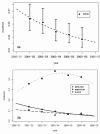The incidence of multidrug and full class resistance in HIV-1 infected patients is decreasing over time (2001-2006) in Portugal
- PMID: 18241328
- PMCID: PMC2265747
- DOI: 10.1186/1742-4690-5-12
The incidence of multidrug and full class resistance in HIV-1 infected patients is decreasing over time (2001-2006) in Portugal
Abstract
Despite improvements in HIV treatment, the prevalence of multidrug resistance and full class resistance is still reported to be increasing. However, to investigate whether current treatment strategies are still selecting for multidrug and full class resistance, the incidence, instead of the prevalence, is more informative. Temporal trends in multidrug resistance (MDR defined as at most 1 drug fully susceptible) and full class resistance (FCR defined as no drug in this class fully susceptible) in Portugal based on 3394 viral isolates genotyped from 2000 to 2006 were examined using the Rega 6.4.1 interpretation system. From July 2001 to July 2006 there was a significant decreasing trend of MDR with 5.7%, 5.2%, 3.8%, 3.4% and 2.7% for the consecutive years (P = 0.003). Multivariate analysis showed that for every consecutive year the odds of having a new MDR case decreased with 20% (P = 0.003). Furthermore, a decline was observed for NRTI- and PI-FCR (both P < 0.001), whereas for NNRTI-FCR a parabolic trend over time was seen (P < 0.001), with a maximum incidence in 2003-'04. Similar trends were obtained when scoring resistance for only one drug within a class or by using another interpretation system. In conclusion, the incidence of multidrug and full class resistance is decreasing over time in Portugal, with the exception of NNRTI full class resistance which showed an initial rise, but subsequently also a decline. This is most probably reflecting the changing drug prescription, the increasing efficiency of HAART and the improved management of HIV drug resistance. This work was presented in part at the Eighth International Congress on Drug Therapy in HIV Infection, Glasgow (UK), 12-16 November 2006 (PL5.5); and at the Fifth European HIV Drug Resistance Workshop, Cascais (Portugal), 28-30 March 2007 (Abstract 1).
Figures


References
-
- Murphy EL, Collier AC, Kalish LA, Assmann SF, Para MF, Flanigan TP, Kumar PN, Mintz L, Wallach FR, Nemo GJ. Highly active antiretroviral therapy decreases mortality and morbidity in patients with advanced HIV disease. Ann Intern Med. 2001;135:17–26. - PubMed
-
- Vandamme AM, Van Vaerenbergh K, De Clercq E. Anti-human immunodeficiency virus drug combination strategies. Antivir Chem Chemother. 1998;9:187–203. - PubMed
-
- Bannister WP, Kirk O, Gatell JM, Knysz B, Viard JP, Mens H, Monforte AD, Phillips AN, Mocroft A, Lundgren JD. Regional changes over time in initial virologic response rates to combination antiretroviral therapy across Europe. J Acquir Immune Defic Syndr. 2006;42:229–237. doi: 10.1097/01.qai.0000214815.95786.31. - DOI - PubMed
Publication types
MeSH terms
Substances
LinkOut - more resources
Full Text Sources
Medical
Research Materials
Miscellaneous

